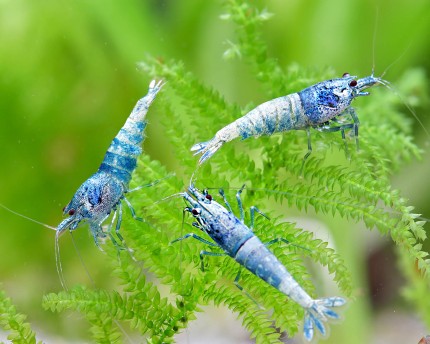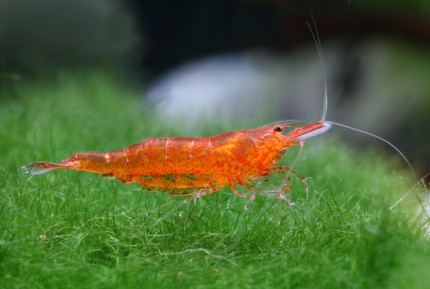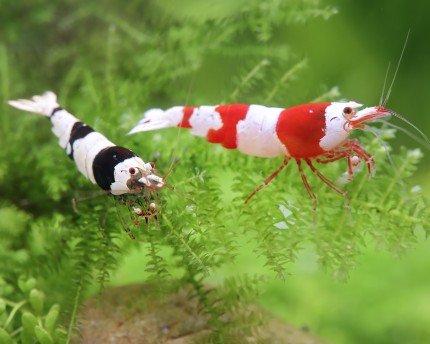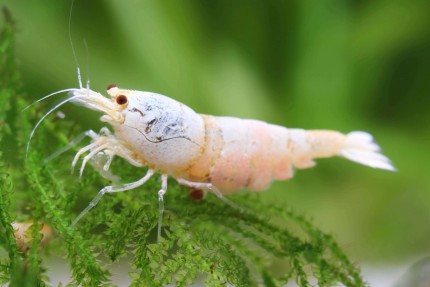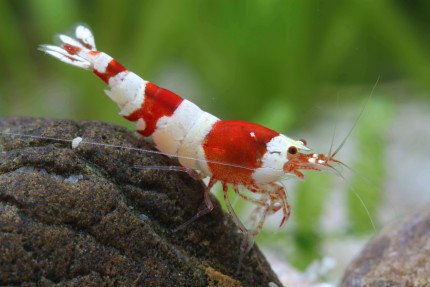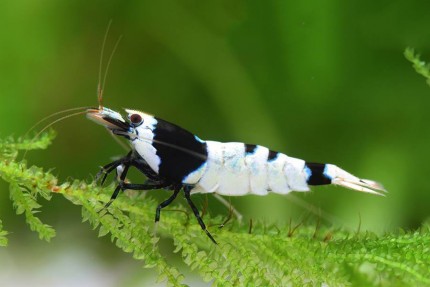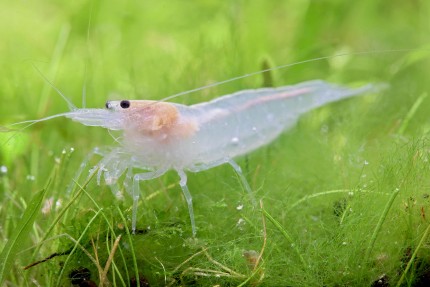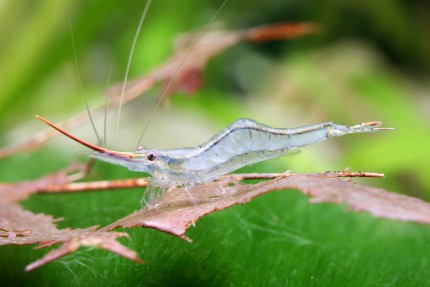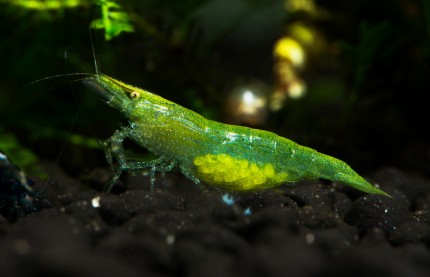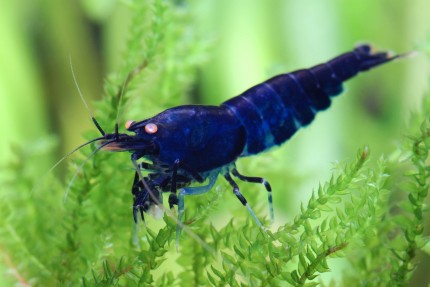Most shrimp in the hobby belong to the genus Caridina. The best known is the robust Amana shrimp Caridina multidentata (formerly: Caridina japonica). It is also bred in the hobby, although this breeding is not so easy - the larvae need brackish water to develop into shrimp. The Amano shrimp, also known as Yamato shrimp or Yamatonuma shrimp in Japanese, is one of the best and most effective thread algae eaters available. In the aquarium the rather large animals are to be kept in tanks from 60 cm edge length. Especially the females need a higher protein content in their food than other types of dwarf shrimp. The Amano shrimp became famous through the aquascaper Takashi Amano, who used it as a reliable algae eater in practically all his aquascapes.
Among the Caridina there is also the beautiful red and white or black and white patterned bee shrimp Caridina logemanni with its countless pattern variations, for which there is an elaborate list of grades. Red Bee and Black Bee is the English name for the red and black bee shrimp. The high breedings trace back to the black transparent to black white wild type that lives in soft, clean and slightly acidic streams in southern China. The bee shrimp is also an omnivore among the dwarf shrimp, but should be fed a rather vegetable diet and only occasionally get stronger protein food.
Bee shr imp and tiger shr imp as well as the Tangerine Tiger, Aura Blue and the Spotted shr imp belong to the group around Caridina serrata. The bee shrimp, all its color variants and their relatives are happy in the aquarium with soft and slightly acidic water with a pH value below 7. Carbonate hardness should not be present at all - something that is usually not possible with tap water in Germany. Resourceful breeders resort to osmosis water, which they can remineralize with a mineral salt mixture specially adapted to bee shrimp and thus ideally adjust to the values preferred by these beautiful shrimp.
The patterns in high breeding Red Bees and Black Bees are divided into different grades. The breeding goal here is always clearly separated, opaque colors, if possible without transparent areas and solid colored legs.
Grade B is far away from this breeding goal. Here, the pattern is still irregular and appears partly quite blotchy.
Grade A has a better color quality. These red bee shrimp or black bee shrimp have three to four white, clearly separated from the colored areas continuous cross bands, they are also called three band or four band shrimp.
Grade S summarizes a whole number of patterns in the bee shrimp. Here the colored bands partially dissolve. Among the Grade S falls the V-band (with a pointed downward narrowed colored band on the abdomen), the Tigertooth / Tiger tooth with two prongs on the abdomen and the Hinomaru with a colored band and a colored spot (Hinomaru is the name of the Japanese flag, to which the red spot on a white background in the Red Bee reminds).
In the Bee Shrimp Grade SS, the total white area increases. This includes the Double Hinomaru, in which the last colored stripe on the abdomen is also resolved to a more or less circular spot. The No Entry also belongs here. In the No Entry, the larger colored spot has a white horizontal stripe, which looks exactly like a one-way street sign in the red animals. In the Halfmoon, only a crescent half of the colored patch remains, and the Little Lips has a wider white horizontal stripe in the colored patch.
In the Grade SSS, the white areas take over the main role in the Red Bee or Black Bee. In these patterns, only a small colored patch is present on the very back of the shrimp's abdomen, and in many animals it is missing altogether. Also the colored areas on the head carapace / carapax are here increasingly interrupted by white areas. The Mosura still has an almost continuous red or black head carapace, already in the Mosura Crown you can see directly behind the eyes in the center of the head a colored spot, which is separated by a white band from the rest of the colored head carapace and looks like a small crown. The Mosura Heart has a larger, heart-shaped white area behind the eyes, and in the Flowerhead, the red or black areas on the head carapace dissolve and are so interspersed with white areas that they almost look like a flower pattern. If the colored areas are rather thin, it is also called a Lightning (i.e. a pattern of lightning bolts).
The Super Crystal Red is another variation of the Bee Shrimp and is characterized by a more or less complete red coloration. White markings on the tail fan, sporadically on the abdomen and also on the head of the shrimp are allowed. Ideally, Super Crystal Red dwarf shrimp have completely red colored legs. Many breeders have been dealing with the Super Crystal Red for quite a while, and accordingly the strains have already reached a very high quality in terms of color density and color coverage.
The Super Crystal Black is a relatively new color form of the Black Bee. The pure black is an ambitious breeding goal, which more and more breeders are approaching through patient and careful work. If the legs are then also colored throughout, the breeder's dream becomes true.
The Shadow Shrimp or Taiwan Bees are divided into other grades. The King Kong is mainly black, the Black Panda has a banded pattern. In the red Shadows we have the Wine Red with its banded pattern and the Red Ruby with its predominantly red pattern. There are other patterns here like the Pinto shrimp which has spots or the Zebra Pinto with its fine horizontal stripes. The Blue Bolt is blue or blue-white, the Red Bolt is reddish. With the Shadow Shrimps there is still a lot of breeding going on, here are constantly more breeding forms.

